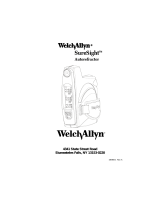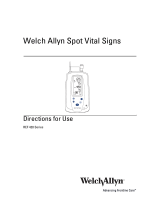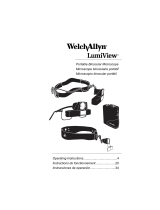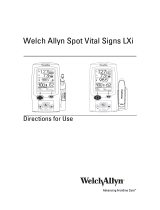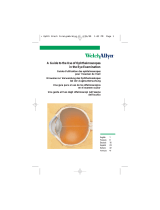La page est en cours de chargement...

4341 State Street Road
Skaneateles Falls, NY 13153-0220
719919 Rev. A


Table of Contents
Warnings & Symbols ..............................1
Mises en garde et symboles ........................4
Technical Specifications ............................8
Function and Intended Application...................10
Vision Disorders and Amblyopia ..................10
SureSight™..................................11
SureSight Display, Controls, and Features.............12
First Time Set-Up ................................14
Stand.......................................14
Controls.....................................15
Pre-test Set-up:...............................15
Test Procedure:...............................16
Important Operating Tips .......................17
Helpful hints for testing pre-schoolers .............17
Results .....................................18
Approximate Relationship of Sphere to Visual Acuity. . 19
Referral Criteria...............................19
Plus or Minus Cylinder Convention................21
Updating SureSight Software ....................21
Replacement and Recycling of Battery ...............22
Replacing the Battery ..........................22
Charging ....................................22
Recycling Lithium Ion Battery....................23

Hand Strap Replacement ..........................24
Cleaning and Sterilization of the SureSight ............24
Service, Calibration, and Warranty Information .........25
Warranty ....................................25
Service and Warranty ..........................26
SureSight Rechargeable Battery..................26
Calibration and Maintenance.....................26
Appendix ......................................27
Glossary of Terms.............................27
Guidance and Manufacturer’s Declarations ............27
Emissions and Immunity Information ..............27

1
Warnings & Symbols
ATTENTION: Refer to the operating instructions. This symbol ( ) is
intended to advise the user of the presence of important operating or
maintenance instructions in the documents accompanying the
instrument.
WARNING: Do not modify this equipment. Any modification of this
equipment can lead to patient injury. Any modification of this equip-
ment voids the product warranty.
Service or Repair to be performed by qualified, authorized personnel
only. There are no user serviceable parts inside the instrument.
Opening this device can expose the user to harmful invisible laser
radiation.
Use only with Welch Allyn 710 series chargers.
Replacement parts and accessories - Use only approved replacement
parts and accessories specified in this manual. Refer to the
maintenance section of this manual for more information.
Do not sterilize the instrument or any of its components.
Use only with IEC 60601-1 approved printers, or keep printer out of
patient vicinity.
Disassembly of instrument beyond the extent described in this
manual will void the warranty. Refer all servicing to Welch Allyn or a
Welch Allyn authorized service representative listed in the Servicing,
Calibration and Warranty Information section. Opening this device
can expose the user to harmful invisible laser radiation. Only the
battery cover is to be opened by the user.
As a precaution, avoid using this product in close proximity to other
equipment. The product complies with current required standards for
electromagnetic interference and should not present problems to
other equipment or be affected by other devices.

2
Battery replacement: Replace with Welch Allyn model # 72420
Lithium Ion battery only.
Do not attempt to disassemble or modify the battery pack. There are
no user serviceable parts inside pack.Do not attempt to directly solder
to the battery pack.
Do not attempt to connect the positive and negative battery terminals
to each other, nor to any other device.
“Caution” - use of controls or adjustments or performance of
procedures other than those specified herein may result in hazardous
radiation exposure.
Product contains two internal apertures within the laser tube
assembly. These are not user replaceable or user adjustable. DO NOT
attempt to make any aperture adjustments to this product.
Do not operate, charge, leave or discard battery pack in any
environment where it may exceed 0°C to 40°C.
Do not immerse the battery pack in water.
Do not attempt to open or pierce the battery pack.
Do not strike or throw the battery pack.
Do not use a battery pack which appears to be deformed, leaking,
corroded, or is otherwise irregular.
If electrolyte leaking from battery contacts your skin or eyes, rinse
with running water and immediately seek medical attention.
If the device will be unused for several months or longer, remove the
battery prior to storing the device.
IPXØ: Not protected against the ingress of water.
Not for use in the presence of flammable anesthetics.

3
Double Insulated.
Australia EMC Framework Compliance
The CE mark on this device indicates that it has been tested and
conforms to the provisions noted within the 93/42/EEC Medical
Device Directive.

4
Mises en garde et symboles
ATTENTION : Consulter le mode d'emploi. Ce symbole ( )
signale à l’utilisateur la présence de renseignements importants
relatifs au fonctionnement ou à l'entretien de l'instrument dans les
documents qui l'accompagnent.
AVERTISSEMENT : Ne modifiez pas l’équipement. Toute modifica-
tion de l’équipement peut être source de blessures au patient. Toute
modification de l’équipement annule la garantie produit.
L'entretien ou la réparation ne doivent être effectués que par un
personnel compétent habilité. Cet instrument ne contient pas de
pièces réparables par l'utilisateur. L'ouverture de ce dispositif risque
d'exposer l'utilisateur à un rayonnement laser invisible nocif.
Utiliser uniquement avec des chargeurs Welch Allyn série 710.
Pièces et accessoires de rechange – Utiliser uniquement les pièces
et accessoires de rechange autorisés spécifiés dans ce manuel.
Consulter la section Entretien de ce manuel pour des informations
supplémentaires.
Ne pas stériliser l'instrument ni aucun de ses composants.
Utiliser uniquement avec une imprimante conforme à la norme CEI
60601-1, ou utiliser l'imprimante à distance du patient.
Un démontage de l'instrument au-delà des recommandations de ce
manuel annule la garantie. Confier toutes réparations à Welch Allyn
ou à un représentant agréé par Welch Allyn listé dans la section
Informations sur les réparations, l'étalonnage et la garantie.
L'ouverture de ce dispositif risque d'exposer l'utilisateur à un
rayonnement laser invisible nocif. Seul le couvercle de la batterie
peut être ouvert par l'utilisateur.

5
Avertissement : À titre de précaution, éviter d’utiliser le produit en
proximité étroite avec d’autres appareils. Le produit est conforme
aux normes actuelles en matière d’interférences électromagnétiques
et ne devrait pas causer de problème à d’autres appareils ni être
affecté par leur fonctionnement.
Remplacement de la batterie : Remplacer uniquement par une
batterie au lithium Welch Allyn modèle n
o
72420.
Ne pas essayer de démonter ou de modifier le bloc-batterie. Il ne
contient pas de pièces réparables par l'utilisateur.
Ne pas essayer de souder directement sur le bloc-batterie.
Ne pas essayer de relier les bornes positive et négative l'une à
l'autre, ou à d'autres dispositifs.
Attention : Des procédures de contrôle, de réglage ou de
performance autres que celles qui sont spécifiées dans cette notice
peuvent entraîner une exposition dangereuse au rayonnement.
Le produit comprend deux ouvertures internes à l’intérieur du tube
laser. L’utilisateur ne doit ni les ajuster, ni les remplacer. NE JAMAIS
essayer d’ajuster une ouverture sur ce produit.
Ne pas activer, charger, laisser ou jeter le bloc-batterie à un endroit où
la température ambiante est inférieure à 0° C ou supérieure à 40
°
C.
Ne pas immerger le bloc-batterie dans l'eau.
Ne pas essayer d'ouvrir ou de percer le bloc-batterie.
Ne pas frapper ni lancer le bloc-batterie.

6
Double isolation.
Obedece la norma australiana EMC Framework
La marque CE appliquée sur ce dispositif indique qu'il a été testé et
déclaré conforme aux dispositions de la directive 93/42 de la CEE
sur les appareils médicaux.
Authorized European Representative Address:
Regulatory Affairs Representative
Welch Allyn, Limited
Navan Business Park
Dublin Road
Navan, County Meath, Republic of Ireland
Ne pas utiliser un bloc-batterie qui semble fuir ou être déformé,
corrodé ou anormal.
En cas de contact cutané ou oculaire avec une fuite d'électrolytes de
la batterie, rincer à l'eau courante et consulter immédiatement un
médecin.
Si l’opérateur prévoit de ne pas utiliser l’appareil pendant plusieurs
mois, voire plus, retirer la batterie avant de stocker l’appareil.
IPXØ : Non protégé contre l’infiltration d'eau.
Ne pas utiliser en présence d'anesthésiques inflammables.

7
Note: This product contains no hazardous materials. Its disposal will not
contaminate or harm the environment, or present any risk to individuals disposing
of the product. As a precaution, it is recommended you contact your local
disposal and/or recycling authority for information regarding the disposal of the
equipment.

8
Technical Specifications
Technology: Welch Allyn proprietary autorefractor hardware/
algorithm
Working distance: 14 inches (35 cm.)
Distance detection: Automatic, with audible and visual cues
Eyepiece: Illuminated target for easy aiming
Data acquisition time: 2.4s/eye
Data acquisition: Measures and averages 5 to 8 readings/eye
Measurement Range: Sphere: +5.5 to -5.0 Diopters
Cylinder: +/- 3 Diopters
Reliability measure: Indicates number of and variation among
measurements for the given eye
Diopter display: 1/8 or 1/4 diopter increments
Axis: 1° increments
Stand: Compact charger and SureSight storage
Weight: Approximately 2.0 lbs. (0.9 Kg.)
Dimensions: 6.5” x 7.75” x 2”
Interfaces: Remote infrared link to thermal printer.
RS-232 interface for IBM compatible PC for future
software upgrades/data transfer to electronic
medical records.
Laser safety: Class 1 Laser Product per CDRH 21CFR 1040.10 and
1040.11, IEC 60825-1:2001
The maximum output of the laser radiation not to
exceed 33 W at a wavelength of 785 nm.

9
Patents: US 6,007,204 and Des. 413,979 International Patents
Pending
Office illumination: Not for use in direct sunlight. Indoor operation only.
Materials: This product is latex free.
Safety, EMC, and CAN/CSA C22.2 No. 601.1
Regulatory Compliance: CAN/CSA C22.2 No. 601.1.2
CAN/CSA C22.2 No. 601.1.4
IEC/EN 60601-1
IEC/EN 60601-1-2
IEC/EN 60601-1-4
ANSI/AAMI ES60601-1
Environmental Specifications
Transport/Storage: -20°C~49°C, 10%(100% R.H. Max, 500hPa -
1060hPa Altitude
Operating: 10°C~30°C, 30%(75% R.H. Max, 500hPa - 1060hPa
Altitude
Battery Specifications
Battery voltage: 7.2v nominal (Lithium Ion)
Battery life: More than 3 hours of continuous usage
Low-Battery warning: Indicates 10 - 15 minutes usage remains
Classifications
Protection against electric shock: Class II equipment and internally powered.
Mode of operation: Continuous use
Method of sterilization: Refer to Cleaning and Sterilization of the SureSight

10
Function and Intended Application
Thank you for purchasing the Welch Allyn SureSight™ Vision Screener. Please
read and follow the instructions found in this manual before using your new Vision
Screener to ensure accurate and reliable service.
Vision Disorders and Amblyopia
Amblyopia (lazy eye) is the leading cause of monocular blindness in North
America for those under 70. However, if risk factors are detected by age 4, 95%
of patients can have their vision saved and avoid the lifelong effects of amblyopia,
which may include a dramatically higher chance of loss of sight in the other eye,
learning delays, and limitation of career choices.
Two-thirds of children with amblyopic risk factors have refractive error (when the
eye’s optics fail to clearly focus images on the retina). These include
anisometropia (unequal optical power of the two eyes), myopia and hyperopia
(near- and far-sightedness), and astigmatism (asymmetry of focus). Furthermore,
20% of teenagers suffer from a refractive error that requires corrective lenses
that can affect educational development when untreated.
The American Academy of Pediatrics, Family Practice, Ophthalmology, and
Optometry all advocate pre-school vision screening, especially a key check of
children aged 3 to 4. The latest research also indicates that it is a good idea to
check refraction in infants - and to begin treatment by age one. Early detection
reduces treatment time and expense and improves outcomes.
Traditionally, pediatricians and family physicians use visual acuity (eye) charts to
screen for refractive vision problems. Unfortunately, acuity testing of pre-
schoolers suffers from low compliance, poor specificity (false positives), and poor
sensitivity (false negatives).

11
SureSight™
That’s why Welch Allyn created SureSight™, the first objective, accurate vision
test that ensures reliable early detection of refractive error, the primary vision
disorder in children. Early detection improves outcomes and reduces treatment
duration.
The handheld SureSight vision screener addresses the problems associated with
eye chart acuity screenings - and it’s effective anywhere in the office or offsite.
And since minimal patient interaction is required, SureSight can be used for
screening infants or handicapped patients. SureSight can also automatically test
adults. With SureSight you can finally screen for serious vision problems - at well
child visits or anytime - efficiently and effectively.

12
SureSight Display, Controls, and Features
“Right” eye field
Sphere
(see glossary)
Cylinder
(see glossary)
Difference
between the eyes
Child/adult
calibration
Peephole with
crosshair target
for aiming
Reliability measure
“Left” eye field
Print and left/
right toggle
Start Button
Self-adjusting
hand strap

13
Charging Jack Receptacle
Receptacle for
RS232 Connection
Battery Compartment
Fixation LEDs
Distance Sensor
IR link to printer

14
First Time Set-Up
Stand
• Insert right angle connector into stand
• Optional: Two strips of hook and loop fasteners are provided on the stand.
Attach mating strips to countertop or “home” location of the stand. For best
results, clean surface and allow to dry before adhering. Hook and loop
fasteners keep stand firmly in place for use, while allowing it to be removed
as needed for offsite screenings.
• Insert battery:
1) Open the battery cover located on the underside of the unit by sliding it in
the direction indicated by the arrow and lifting out.
2) Insert the new battery into the compartment in the direction of the arrow
on the battery itself, so that the terminal end enters the compartment
first. If necessary, rotate the lever obstructing the compartment in a
clockwise direction until the compartment is unobstructed.
NOTE: Insert the battery only as directed. Failure to do so will prevent the
instrument from functioning.
3) While pushing in on the battery, rotate the lever in a counter-clockwise
direction until it covers the battery.
4) Replace the cover by lightly pushing in on the raised end until it is level
and sliding the cover in the opposite direction of the arrow until it locks
into place.

15
Controls
The buttons on the back of the instrument function as follows:
The instrument will turn off when unused for 1 minute. Any button pressed on
the SureSight will bring up results.
Pre-test Set-up:
• Push any button to turn the unit on.
• Position the patient so that the test can be conducted level with, and square
to, patient’s eyes.
• Choose the appropriate calibration using the child/adult button (child mode for
6 yr. and under). Hold button until you hear a double beep and see the desired
icon on the LCD.
• Explain the test procedure to the patient:
• “Now I will check your eyes. You will see a red light in the middle of the
blinking green lights.”
• Position yourself at eye-level and square with the face of the patient.
Left/Right Toggle & Print
• Selects single eye to re-test or
switches back to regular test.
• Prints results (hold button down
while aiming patient side of
SureSight at printer until you
hear “tah-dah”
Clear and Child/Adult
Calibration
• Clears readings
• Changes child/adult
(hold down)
“GO” Button
• Unit on: starts test
• Unit off: recalls old
readings

16
Test Procedure:
• Push the “GO” button on the unit
•
Check that the patient is fixated correctly throughout the test.
• Position the unit at the correct distance from the patient:
• When the unit is too far away, you will hear slow, low-pitched beeps. ••••
• Slowly move closer. At the correct distance (14”), you will hear a steady,
low tone. ———
• When the unit is too close, you will hear quick, high-pitched beeps.
……
• The crosshair will flash in synch with the tones.
• Look through the peephole and align the crosshair on the pupil of the
patient’s right eye. While the unit is acquiring data, you will hear a very high-
pitched chirping sound over the steady low tone. °°°°°
• If you are not acquiring data (steady tone without acquiring data chirps):
• Scan around the pupil in an outward-moving spiral until chirps begin, then
hold this location.
• Ask the patient if they can see the red light.
• When the test of the right eye is complete, you will hear the “tah-dah”
sound. (Testing resumes after 1 second, so you do not need to press any
buttons for the left eye test.)
• Without changing position, rotate the unit to the left eye and align the
crosshair over the pupil. Repeat test.
• At the end of the test, you will hear the “tah-dah” sound again.
• If the unit has not gathered enough good readings from either eye, you will
hear 5 tones when the test stops. ----- Youmust re-test that eye.
• To stop a test at any time, hold any button until 5 tones sound.
1/40

